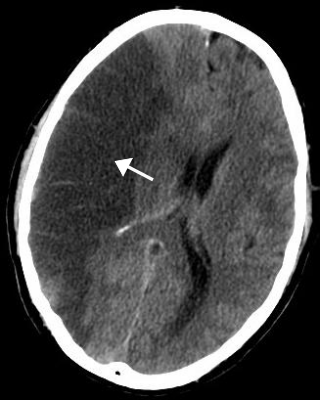Related Research Articles

A cough is a sudden expulsion of air through the large breathing passages which can help clear them of fluids, irritants, foreign particles and microbes. As a protective reflex, coughing can be repetitive with the cough reflex following three phases: an inhalation, a forced exhalation against a closed glottis, and a violent release of air from the lungs following opening of the glottis, usually accompanied by a distinctive sound.

Stroke is a medical condition in which poor blood flow to the brain causes cell death. There are two main types of stroke: ischemic, due to lack of blood flow, and hemorrhagic, due to bleeding. Both cause parts of the brain to stop functioning properly.

Death from laughter is an extremely rare form of death, usually resulting from either cardiac arrest or asphyxiation, that has itself been caused by a fit of laughter. Though uncommon, death by laughter has been recorded from the times of ancient Greece to modern times.
Pemberton's sign was named after Hugh Pemberton, who characterized it in 1946.
Cataplexy is a sudden and transient episode of muscle weakness accompanied by full conscious awareness, typically triggered by emotions such as laughing, crying, or terror. Cataplexy affects approximately 20% of people who have narcolepsy, and is caused by an autoimmune destruction of hypothalamic neurons that produce the neuropeptide hypocretin, which regulates arousal and has a role in stabilization of the transition between wake and sleep states. Cataplexy without narcolepsy is rare and the cause is unknown.

Diogenes syndrome, also known as senile squalor syndrome, is a disorder characterized by extreme self-neglect, domestic squalor, social withdrawal, apathy, compulsive hoarding of garbage or animals, and a lack of shame. Affected people may also display symptoms of catatonia.
Pseudobulbar affect (PBA), or emotional incontinence, is a type of neurological disorder characterized by uncontrollable episodes of crying or laughing. PBA occurs secondary to a neurologic disorder or brain injury. Patients may find themselves crying uncontrollably at something that is only slightly sad, being unable to stop themselves for several minutes. Episodes may also be mood-incongruent: a patient may laugh uncontrollably when angry or frustrated, for example. Sometimes, the episodes may switch between emotional states, resulting in the patient crying uncontrollably before dissolving into fits of laughter.

Enoxacin is an oral broad-spectrum fluoroquinolone antibacterial agent used in the treatment of urinary tract infections and gonorrhea. Insomnia is a common adverse effect. It is no longer available in the United States.
A gelastic seizure, also known as "gelastic epilepsy", is a rare type of seizure that involves a sudden burst of energy, usually in the form of laughing. This syndrome usually occurs for no obvious reason and is uncontrollable. It is slightly more common in males than females.
The Gruppo Italiano per lo Studio della Sopravvivenza nell'Infarto Miocardico (GISSI) is a cardiology research group founded as a collaboration between two Italian organisations – the Mario Negri Institute and the Associazione Nazionale dei Medici Cardiologi Ospedalieri (ANMCO).

Narcolepsy is a chronic neurological disorder that involves a decreased ability to regulate sleep–wake cycles. Symptoms often include periods of excessive daytime sleepiness and brief involuntary sleep episodes. Narcolepsy paired with cataplexy is evidenced to be an autoimmune disorder. These experiences of cataplexy can be brought on by strong emotions. Less commonly, there may be vivid hallucinations or an inability to move while falling asleep or waking up. People with narcolepsy tend to sleep about the same number of hours per day as people without it, but the quality of sleep tends to be lessened.
The International Studies of Infarct Survival (ISIS) were four randomized controlled trials of several drugs for treating suspected acute myocardial infarction. More than 134,000 patients from over 20 countries took part in four large simple trials between 1981 and 1993, coordinated from Oxford, England.
Pitolisant, sold under the brand name Wakix among others, is a medication used for the treatment of excessive daytime sleepiness in adults with narcolepsy. It is a histamine 3 (H3) receptor antagonist/inverse agonist (an antihistamine drug specific to that kind of receptors). It represents the first commercially available medication in its class, so that the US Food and Drug Administration (FDA) declares it a first-in-class medication. Pitolisant enhances the activity of histaminergic neurons in the brain that function to improve a person's wakefulness. It was approved by the European Medicines Agency (EMA) in March 2016 for narcolepsy with or without cataplexy, and for excessive daytime sleepiness by the FDA in August 2019. The most common side effects include difficulty sleeping, nausea, and feeling worried.

Syncope, commonly known as fainting or passing out, is a loss of consciousness and muscle strength characterized by a fast onset, short duration, and spontaneous recovery. It is caused by a decrease in blood flow to the brain, typically from low blood pressure. There are sometimes symptoms before the loss of consciousness such as lightheadedness, sweating, pale skin, blurred vision, nausea, vomiting, or feeling warm. Syncope may also be associated with a short episode of muscle twitching. Psychiatric causes can also be determined when a patient experiences fear, anxiety, or panic; particularly before a stressful event, usually medical in nature. When consciousness and muscle strength are not completely lost, it is called presyncope. It is recommended that presyncope be treated the same as syncope.
Idiopathic hypersomnia(IH) is a neurological disorder which is characterized primarily by excessive sleep and excessive daytime sleepiness (EDS). Idiopathic hypersomnia was first described by Bedrich Roth in 1976, and it can be divided into two forms: polysymptomatic and monosymptomatic. The condition typically becomes evident in early adulthood and most patients diagnosed with IH will have had the disorder for many years prior to their diagnosis. As of August 2021, an FDA-approved medication exists for IH called Xywav, which is oral solution of calcium, magnesium, potassium, and sodium oxybates; in addition to several off-label treatments (primarily FDA-approved narcolepsy medications).

Vera Rich was a British poet, journalist, historian, and translator from Belarusian and Ukrainian.
Necrotizing pneumonia (NP), also known as cavitary pneumonia or cavitatory necrosis, is a rare but severe complication of lung parenchymal infection. In necrotizing pneumonia, there is a substantial liquefaction following death of the lung tissue, which may lead to gangrene formation in the lung. In most cases patients with NP have fever, cough and bad breath, and those with more indolent infections have weight loss. Often patients clinically present with acute respiratory failure. The most common pathogens responsible for NP are Streptococcus pneumoniae, Staphylococcus aureus, Klebsiella pneumoniae. Diagnosis is usually done by chest imaging, e.g. chest X-ray, CT scan. Among these CT scan is the most sensitive test which shows loss of lung architecture and multiple small thin walled cavities. Often cultures from bronchoalveolar lavage and blood may be done for identification of the causative organism(s). It is primarily managed by supportive care along with appropriate antibiotics. However, if patient develops severe complications like sepsis or fails to medical therapy, surgical resection is a reasonable option for saving life.
Aristolochia fangchi, is a species of flowering plant in the family Aristolochiaceae, native to Vietnam and southeast and south-central China.
Autosomal dominant cerebellar ataxia, deafness, and narcolepsy (ADCADN) is a rare progressive genetic disorder that primarily affects the nervous system and is characterized by sensorineural hearing loss, narcolepsy with cataplexy, and dementia later in life. People with this disorder usually start showing symptoms when they are in their early-mid adulthoods. It is a type of autosomal dominant cerebellar ataxia.
Pediatric narcolepsy refers to conditions of narcolepsy during childhood and adolescence. In a pediatric setting, people with narcolepsy still exhibit the classical tetrad symptoms of narcolepsy, and thus is possible for both type 1 and type 2 narcolepsy to develop in adolescence.
References
- ↑ Cox SV, Eisenhauer AC, Hreib K (October 1997). "Seinfeld syncope". Catheterization and Cardiovascular Diagnosis. 42 (2): 242. doi:10.1002/(SICI)1097-0304(199710)42:2<242::AID-CCD41>3.0.CO;2-M. PMID 9328725.
- ↑ Khan, Z; Trotti, LM (July 2015). "Central Disorders of Hypersomnolence: Focus on the Narcolepsies and Idiopathic Hypersomnia". Chest. 148 (1): 262–273. doi:10.1378/chest.14-1304. PMC 4694150 . PMID 26149554.
- ↑ Bloomfield and Jazrawi; Jazrawi, S (2005). "Shear Hilarity Leading to Laugh Syncope in a Healthy Man". Journal of the American Medical Association. 293 (23): 2863–2864. doi:10.1001/jama.293.23.2863-b. PMID 15956630.